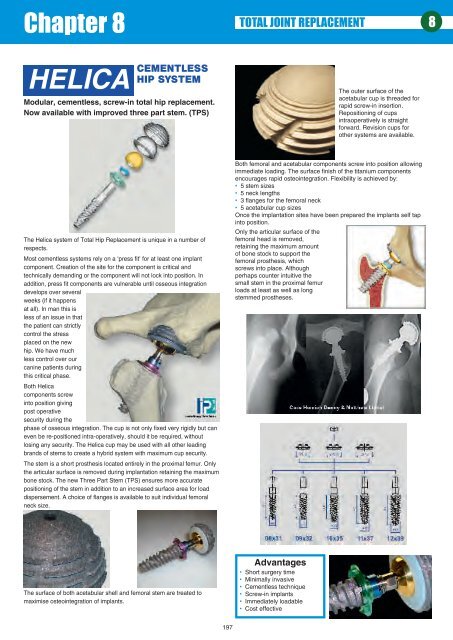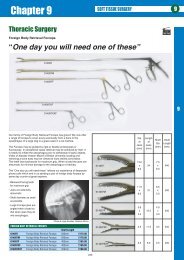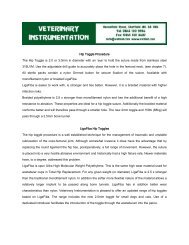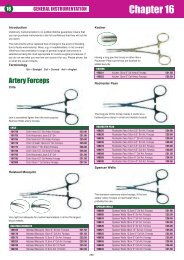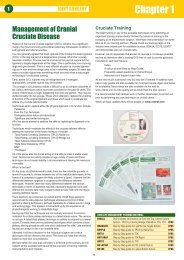HELICA - Veterinary Instrumentation
HELICA - Veterinary Instrumentation
HELICA - Veterinary Instrumentation
You also want an ePaper? Increase the reach of your titles
YUMPU automatically turns print PDFs into web optimized ePapers that Google loves.
Chapter 8<br />
TOTAL JOINT REPLACEMENT 8<br />
<strong>HELICA</strong> CEMENTLESS<br />
HIP SYSTEM<br />
Modular, cementless, screw-in total hip replacement.<br />
Now available with improved three part stem. (TPS)<br />
The outer surface of the<br />
acetabular cup is threaded for<br />
rapid screw-in insertion.<br />
Repositioning of cups<br />
intraoperatively is straight<br />
forward. Revision cups for<br />
other systems are available.<br />
The Helica system of Total Hip Replacement is unique in a number of<br />
respects.<br />
Most cementless systems rely on a ‘press fit’ for at least one implant<br />
component. Creation of the site for the component is critical and<br />
technically demanding or the component will not lock into position. In<br />
addition, press fit components are vulnerable until osseous integration<br />
develops over several<br />
weeks (if it happens<br />
at all). In man this is<br />
less of an issue in that<br />
the patient can strictly<br />
control the stress<br />
placed on the new<br />
hip. We have much<br />
less control over our<br />
canine patients during<br />
this critical phase.<br />
Both Helica<br />
components screw<br />
into position giving<br />
post operative<br />
security during the<br />
phase of osseous integration. The cup is not only fixed very rigidly but can<br />
even be re-positioned intra-operatively, should it be required, without<br />
losing any security. The Helica cup may be used with all other leading<br />
brands of stems to create a hybrid system with maximum cup security.<br />
The stem is a short prosthesis located entirely in the proximal femur. Only<br />
the articular surface is removed during implantation retaining the maximum<br />
bone stock. The new Three Part Stem (TPS) ensures more accurate<br />
positioning of the stem in addition to an increased surface area for load<br />
dispersement. A choice of flanges is available to suit individual femoral<br />
neck size.<br />
Both femoral and acetabular components screw into position allowing<br />
immediate loading. The surface finish of the titanium components<br />
encourages rapid osteointegration. Flexibility is achieved by:<br />
• 5 stem sizes<br />
• 5 neck lengths<br />
• 3 flanges for the femoral neck<br />
• 5 acetabular cup sizes<br />
Once the implantation sites have been prepared the implants self tap<br />
into position.<br />
Only the articular surface of the<br />
femoral head is removed,<br />
retaining the maximum amount<br />
of bone stock to support the<br />
femoral prosthesis, which<br />
screws into place. Although<br />
perhaps counter intuitive the<br />
small stem in the proximal femur<br />
loads at least as well as long<br />
stemmed prostheses.<br />
The surface of both acetabular shell and femoral stem are treated to<br />
maximise osteointegration of implants.<br />
Advantages<br />
• Short surgery time<br />
• Minimally invasive<br />
• Cementless technique<br />
• Screw-in implants<br />
• Immediately loadable<br />
• Cost effective<br />
197
8 TOTAL JOINT REPLACEMENT<br />
<strong>HELICA</strong> Surgical Technique<br />
Pre-operative assessment and planning<br />
gives the predicted size of cup, stem and<br />
head / neck.<br />
The acetabulum is prepared by reaming<br />
with progressively larger and larger<br />
reamers finishing with the predicted size.<br />
Using the insertion T grip and alignment<br />
aid the threaded shell for the<br />
acetabulum is positioned ready for<br />
insertion. The threads on the shell are<br />
self tapping and are firmly screwed into<br />
position. After assessment the shell<br />
may be re-positioned if necessary.<br />
The extension pin is added to the<br />
chosen stem to ensure correct<br />
alignment of the stem in the<br />
femoral neck. The stem is slowly<br />
screwed into position until the tip<br />
exits the lateral cortex. The fine<br />
thread at the neck of the stem<br />
should sit below the resection<br />
line. The milling tool will remove<br />
excess bone to leave the<br />
resection line at right angles to<br />
the stem.<br />
The axis is determined in part by eye but<br />
aided by a goniometer. The axis is<br />
established initially by a small drill which is<br />
progressively opened using larger and larger<br />
drills.<br />
The resection of the femoral head<br />
is made just distal to the bonecartilage<br />
interface. The resection<br />
is made perpendicular to the<br />
femoral stem implant axis. The<br />
face of the osteotomy will be<br />
milled at a later stage to ensure<br />
that the bed for the femoral<br />
component flange is aligned<br />
correctly. The osteotomy is<br />
facilitated by use of the Helica<br />
hohman to lift the femoral head.<br />
The milling tool prepares the bone surface for the<br />
flangewhich sits on and spreads the load onto the<br />
femoral neck. The new stem design ensures that<br />
the flange will always sit squarely on the milled<br />
area. The flange is fitted and locked in position by<br />
a locking ring.<br />
The cup inlay is a click fit into the<br />
acetabular shell. Insertion is<br />
accomplished using an insertion tool.<br />
The rim of the inlay should sit flush<br />
with the shell margin.<br />
After trialling, the appropriate<br />
femoral head is locked onto<br />
the femoral neck. The<br />
interface is a very secure<br />
morse taper. Hybrid heads<br />
are available to fit other hip<br />
systems to allow the use of<br />
the Helica cup when revising<br />
other system cup failures.<br />
The selected<br />
head is fitted.<br />
The femoral component must be inserted along the axis of the femoral<br />
neck. It is important to spend time establishing the correct axis.<br />
A CCD angle of 145 to 147 degrees is desirable.<br />
Much thought and care should be taken when placing the initial 2.0 or<br />
2.5mm drill hole which should exit the lateral cortex. Drills of increasing<br />
size are used to open up the femoral neck. Each drill should exit the lateral<br />
cortex. The final drill for the femoral neck will be the pilot drill for the<br />
predicted femoral component.<br />
Correct positioning of the implants<br />
is confirmed by radiography.<br />
This surgical guide is included to give an<br />
over view of the technique. Surgeons<br />
contemplating use of the Helica system<br />
must attend a recognised training course. A<br />
fuller illustrated guide is included.<br />
198
www.vetinst.com<br />
TOTAL JOINT REPLACEMENT 8<br />
<strong>HELICA</strong> Hybrids<br />
The stability of the Helica cup is such that it may be used in conjuction with<br />
press fit cups from other systems either as a revision or as a primary<br />
procedure.<br />
Helica heads are available in various lengths which interface with stems for<br />
the Kyon and BFX systems. These heads fit standard Helica cups. The<br />
tray of acetabular instruments may be purchased separately after<br />
attending an approved training course.<br />
Ancillary Helica <strong>Instrumentation</strong><br />
Meyerding<br />
Hohman<br />
Three instruments, not included in the standard<br />
sets, make osteotomy and alignment of the<br />
femoral stem significantly easier and are<br />
recommended. The Meyerding is a very<br />
powerful hand held retractor.<br />
The Helica Hohman has a dished profile and fine teeth along its leading<br />
edge to lift the femoral head and neck up from the incision for osteotomy.<br />
The goniometer helps the surgeon to establish the correct axis for the<br />
femoral stem at an angle of 145 to 147 degrees.<br />
<strong>HELICA</strong> ANCILLARY INSTRUMENTS<br />
001038 Helica Hohman Large £62.50<br />
001037 Helica Hohman Medium £62.50<br />
001036 Helica Hohman Small £62.50<br />
HE-GONIO Helica Goniometer £57.50<br />
150019 Meyerding Retractor £52.50<br />
Helica Total Hip <strong>Instrumentation</strong><br />
Helica Total Hip Implants (2012 Version)<br />
ACETABULAR CUPS<br />
HE-HC1-T24 Helica 24mm Acetabular Cup £425.00<br />
HE-HC1-T26 Helica 26mm Acetabular Cup £425.00<br />
HE-HC1-T28 Helica 28mm Acetabular Cup £425.00<br />
HE-HC1-T30 Helica 30mm Acetabular Cup £425.00<br />
HE-HC1-T32 Helica 32mm Acetabular Cup £425.00<br />
TPS STEMS (2012 VERSION)<br />
HE-HS3-T0831 TPS Helica Stem 8mm x 31mm (2012 Version) £320.00<br />
HE-HS3-T0932 TPS Helica Stem 9mm x 32mm (2012 Version) £320.00<br />
HE-HS3-T1035 TPS Helica Stem 10mm x 35mm(2012 Version) £320.00<br />
HE-HS3-T1137 TPS Helica Stem 11mm x 37mm(2012 Version) £320.00<br />
HE-HS3-T1239 TPS Helica Stem 12mm x 39mm(2012 Version) £320.00<br />
TPS FLANGE (2012 VERSION)<br />
HE-HF3-T18.5 TPS Helica Flange 18.5mm (inc 1 locking nut) £50.00<br />
HE-HF3-T20 TPS Helica Flange 20.0mm (inc 1 locking nut) £50.00<br />
HE-HF3-T22 TPS Helica Flange 21.5mm (inc 1 locking nut) £50.00<br />
TPS LOCKING NUT (2012 VERSION)<br />
HE-HN3-T08 TPS Helica Locking Nut (for replacement) £15.00<br />
FEMORAL HEADS<br />
HE-FH1-18S Helica 18mm Femoral Head - Short £100.00<br />
HE-FH1-18M Helica 18mm Femoral Head - Medium £100.00<br />
HE-FH1-18L Helica 18mm Femoral Head - Long £100.00<br />
HE-FH1-18XL Helica 18mm Femoral Head - Extra Long £155.00<br />
HE-FH1-18XXL Helica 18mm Femoral Head - XX Long £155.00<br />
INLAYS<br />
HE-AL1-P24 Helica 24mm Inlay £85.00<br />
HE-AL1-P26 Helica 26mm Inlay £85.00<br />
HE-AL1-P28 Helica 28mm Inlay £85.00<br />
HE-AL1-P30 Helica 30mm Inlay £85.00<br />
HE-AL1-P32 Helica 32mm Inlay £85.00<br />
HYBRID REVISION IMPLANTS<br />
HE-FHB-18-0 Helica Hybrid 18mm Femoral Head<br />
Biometric Shank + 0 £155.00<br />
HE-FHB-18-3 Helica Hybrid 18mm Femoral Head<br />
Biometric Shank + 3 £155.00<br />
HE-FHB-18-6 Helica Hybrid 18mm Femoral Head<br />
Biometric Shank + 6 £155.00<br />
HE-FHK-18XS Helica Hybrid 18mm Femoral Head<br />
Kyon Extra Short £155.00<br />
HE-FHK-18S Helica Hybrid 18mm Femoral Head<br />
Kyon Short £155.00<br />
HE-FHK-18M Helica Hybrid 18mm Femoral Head<br />
Kyon Medium £155.00<br />
HE-FHK-18L Helica Hybrid 18mm Femoral Head<br />
Kyon Long £155.00<br />
HE-FHK-18XL Helica Hybrid 18mm Femoral Head<br />
Kyon Extra Long £155.00<br />
Helica Total Hip Stem Implants (Original Version)<br />
These stems are the original design to be used in conjunction with the<br />
original instrumentation.<br />
<strong>HELICA</strong> TOTAL HIP INSTRUMENTATION<br />
HE-KIT Helica Instrument Kit (2012 Version) £5,750.00<br />
STEMS<br />
HE-HS1-T0826 Helica Stem 8mm x 26mm £330.00<br />
HE-HS1-T0928 Helica Stem 9mm x 28mm £330.00<br />
HE-HS1-T1028 Helica Stem 10mm x 28mm £330.00<br />
HE-HS1-T1132 Helica Stem 11mm x 32mm £330.00<br />
HE-HS1-T1232 Helica Stem 12mm x 32mm £330.00<br />
199
8 TOTAL JOINT REPLACEMENT<br />
<strong>Veterinary</strong> <strong>Instrumentation</strong> Modular Hip System<br />
(Cemented)<br />
Femoral Prosthesis<br />
Two stems are available which<br />
are identical distally. Supplied sterile.<br />
FEMORAL PROSTHESIS<br />
150200 Large Stem (Sterile) £240.00<br />
150201 Small Stem (Sterile) £240.00<br />
150300 Long Ball (Sterile) £125.00<br />
150301 Short Ball (Sterile) £125.00<br />
HDTHPDVD Hamish Denny Total Hip DVD £40.00<br />
Acetabular Cups<br />
Photography: Hamish Denny<br />
The modular format gives four different femur combinations. Two stem<br />
sizes are available. The taper neck is the same on both. Two ball options<br />
are available, the ball diameter is 15mm in both cases. The “short neck”<br />
ball when fitted to the standard taper neck gives a short necked prosthesis<br />
and the “long neck” ball gives a long necked prosthesis. When combined<br />
with the two acetabular cups a total of 8 combinations are possible. The<br />
most common combination is a small stem and long neck ball together with<br />
a small acetabular cup.<br />
The surgeon most familiar with the system is Hamish Denny FRCVS, who<br />
helped develop the system and has performed over 200 procedures. He<br />
also produced the instructional DVD which is available on free loan. This is<br />
not a ‘high tech’ system which requires a mass of dedicated<br />
instrumentation and jigs. It is a simple, well proven system which assumes<br />
that the surgeon has the knowledge and expertise to complete the<br />
procedure.<br />
Two sizes are available. The internal diameter is the same, as all the heads<br />
of the femoral components are 15mm in diameter. The only difference<br />
between the cups is the wall thickness and therefore the outside diameter.<br />
All cups are marked with stainless rings to establish cup position on<br />
radiographs. Cups have very deep grooves on the external diameter to<br />
provide good cement keying. Supplied sterile.<br />
ACETABULAR CUPS<br />
150402 Medium Acetabular Cup (Sterile) £135.00<br />
150401 Small Acetabular Cup (Sterile) £135.00<br />
Hatt Spoon<br />
Combination Stem size Neck Acetabular cup<br />
1 Small Stem Short Small<br />
2 Small Stem Long Small<br />
3 Small Stem Short Medium<br />
4 Small Stem Long Medium<br />
5 Large Stem Short Small<br />
6 Large Stem Long Small<br />
7 Large Stem Short Medium<br />
8 Large Stem Long Medium<br />
An alternative to the disarticulator in large dogs. The edge of the spoon is<br />
sharp. As used by Martin Olmstead. The VI version has a narrower shaft<br />
and a fibre handle for ease of use.<br />
HATT SPOON<br />
001092 Hatt Spoon 230mm Scoop 17mm x 30mm £60.00<br />
200
www.vetinst.com<br />
TOTAL JOINT REPLACEMENT 8<br />
Femoral Rasp<br />
Acetabular Skid<br />
The aim of the femoral rasp is to produce a hole the same shape as the<br />
stem of the femoral prosthesis plus a margin for the bone cement. The<br />
femoral rasp can create seating for both stems in that both stems have a<br />
similar profile distally and differ only in the proximal area. To create a<br />
seating for the large stem simply make a deeper hole.<br />
FEMORAL RASP<br />
150005 Femoral Rasp £465.00<br />
Femoral Reamer<br />
A double-ended instrument useful in the dislocation of the femoral head<br />
prior to excision. Also useful in “helping” the head of the femoral prosthesis<br />
into the acetabular cup.<br />
ACETABULAR SKID<br />
6200/05 Acetabular Skid £80.00<br />
Femoral Prosthesis Pusher<br />
Use in conjunction with the femoral rasp to open up the proximal femur.<br />
‘T’ handle format with an overall length of 270mm. Use 6mm for the distal<br />
portion and 8mm proximally.<br />
FEMORAL REAMER<br />
150003 Femoral Reamer 6mm 270mm £225.00<br />
150004 Femoral Reamer 8mm 270mm £225.00<br />
Cylindrical Rasp<br />
This instrument fits both small and large femoral prostheses and allows the<br />
surgeon to position the stem and apply pressure as the cement sets.<br />
FEMORAL PROSTHESIS PUSHER<br />
161602B Femoral Prosthesis Pusher £175.00<br />
Acetabular Cup Positioner<br />
Use to widen opening in femur. Available in 6mm and 8mm diameter.<br />
CYLINDRICAL RASP<br />
150008 Cylindrical Rasp 6mm diameter £225.00<br />
150009 Cylindrical Rasp 8mm diameter £225.00<br />
Acetabular Reamers<br />
Photography: Hamish Denny<br />
Photography: Hamish Denny<br />
This instrument holds the acetabular cup in position as the cement sets.<br />
ACETABULAR CUP POSITIONER<br />
161602A Acetabular Cup Positioner £175.00<br />
Meyerding Retractor<br />
Each reamer is designed to produce a prepared bed for each cup.<br />
The reamer shaft is 1 /4” (6.3mm) to fit air or electric rechargeable drills. The<br />
multi-bladed style has a much longer life than the cheese grater type.<br />
Good soft tissue retraction is essential. The reamer head can be<br />
re-sharpened on an exchange basis.<br />
ACETABULAR REAMERS<br />
150012 Small Acetabular Reamer £225.00<br />
150010 Medium Acetabular Reamer £225.00<br />
A heavy duty retractor for use around the hip.<br />
Much favoured by Martin Olmstead.<br />
MEYERDING RETRACTOR<br />
150019 Meyerding Retractor 16mm £52.50<br />
201
8 TOTAL JOINT REPLACEMENT<br />
Hohman Retractor 20mm Wide with Short Kinked Tip<br />
This Hohman is designed<br />
for femoral neck<br />
retraction for THR.<br />
Please see Page 52 for<br />
further information<br />
HOHMAN RETRACTOR 20MM WIDE WITH SHORT KINKED TIP<br />
001039 Hohman 20mm Wide with Short Kinked Tip £62.50<br />
Heygroves Femur Grasping Forceps<br />
Powerful clamps to lock onto the femoral shaft.<br />
Used to rotate the femoral head outwards for excision.<br />
HEYGROVES FEMUR GRASPING FORCEPS<br />
150017 Heygroves Femur Grasping Forceps 10" £140.00<br />
Lewin Femur Grasping Forceps<br />
Bone Cement<br />
DePuy CMW Bone Cement<br />
Designed for total hip replacement.<br />
CMW is the industry standard.<br />
Various options are available. Also<br />
useful in stabilisation of vertebral<br />
fractures/luxations.<br />
CMW1 is a medium/high viscosity<br />
cement for digital application<br />
CMW2 is a rapid set cement<br />
suitable for the acetabular cup via digital application.<br />
CMW3 is a more fluid cement which is more appropriate for the femoral<br />
component. It is usually applied via a 50ml syringe.<br />
CMW cement comes impregnated with Gentamycin which minimises post<br />
operative infection, the worst complication of the procedure.<br />
CMW BONE CEMENT<br />
160506 CMW1 no Gentamycin 40g £75.00<br />
160500 CMW1 with Gentamycin 20g £95.00<br />
160501 CMW2 with Gentamycin 20g £95.00<br />
160503 CMW3 with Gentamycin 20g £95.00<br />
160504 CMW3 with Gentamycin 40g £115.00<br />
<strong>Veterinary</strong> <strong>Instrumentation</strong> Bone Cement<br />
The curvature and multiple teeth of these forceps match<br />
almost exactly the profile of the large dog femur.<br />
Another Martin Olmstead favourite.<br />
LEWIN FEMUR GRASPING FORCEPS<br />
150018 Lewin Femur Grasping Forceps £90.00<br />
Total Hip Replacement Kit<br />
The Total Hip Replacement kit is a cost effective solution saving over 10%<br />
when compared to the component costs. The set also includes one of each<br />
implant.<br />
Our Total Hip Replacement kit includes the following:<br />
INSTRUMENTS<br />
Cylindrical Rasp 6mm<br />
Cylindrical Rasp 8mm<br />
Femoral Rasp<br />
Femoral Reamer 8mm<br />
Femoral Reamer 6mm<br />
Acetabular Reamer Small<br />
Acetabular Reamer Medium<br />
Stem Positioner<br />
Cup Positioner<br />
Lewin Bone Holding Forceps<br />
Meyerding Retractors x 2<br />
Trial Stem Small<br />
Trial Stem Large<br />
Trial Cup Small<br />
Trial Cup Medium<br />
IMPLANTS<br />
Stem Small<br />
Stem Large<br />
Short Neck Ball<br />
Long Neck Ball<br />
Cup Small<br />
Cup Medium<br />
Training DVD<br />
Stainless Case<br />
Please note that the kit does not<br />
include bone cement.<br />
TOTAL HIP REPLACEMENT KIT<br />
150001 Total Hip Replacement Kit £3,450.00<br />
VETERINARY INSTRUMENTATION BONE CEMENT VACUUM MIX<br />
BC1 High Viscosity 40g £50.00<br />
BC1G High Viscosity 40g with Gentamycin £60.00<br />
BC3G Low Viscosity (syringe) 40g with Gentamycin £60.00<br />
CVAC Mixing System (unit) £62.50<br />
CGUN Application Gun £575.00<br />
BOWLSET Set of 3 Mixing Bowls and Spatula £12.00<br />
SPATDISP Disposable Spatula - non-sterile (100 units) £5.25<br />
SYRINGE 50ml Catheter Mount Syringe. Sterile £3.95<br />
SPATULA Autoclavable Plastic Mixing Spatula £5.75<br />
Antibiotic Impregnated Polymethacrylate Beads<br />
(AIPMMA)<br />
Management of chronic local infections may benefit from the insertion of<br />
antibiotic impregnated polymethacrylate(AIPMMA) beads. The beads are<br />
manufactured from sterile bone cement with the addition of appropriate<br />
antibiotic.<br />
Indications include osteomyelitis and abcessation in the rabbit.<br />
<strong>Veterinary</strong> <strong>Instrumentation</strong> offers two kits for the preparation of AIPMMA<br />
beads. Both kits contain sufficient material for approximately 100 sterile<br />
beads. Store unused beads in sterile containers for maximum shelf life.<br />
Full instructions are included.<br />
ANTIBIOTIC IMPREGNATED POLYMETHACRYLATE BEADS (AIPMMA)<br />
BC1GKIT AIPMMA Bead Kit with Gentamycin £70.00<br />
BC1KIT AIPMMA Bead Kit. No Antibiotic £65.00<br />
202
www.vetinst.com<br />
TOTAL JOINT REPLACEMENT 8<br />
WORK IN PROGRESS<br />
Several joint replacement systems are under development which may be<br />
of interest. Some details are included here. Surgeons who are interested<br />
in being kept informed or take part in trials are invited to e-mail<br />
john@vetinst.com or david@vetinst.com.<br />
ELBOW<br />
‘Sirius’ Total Elbow Replacement<br />
Initial clinical cases have been very encouraging and John is now looking<br />
for candidates for clinical trials. Individuals interested in becoming involved<br />
should contact:-<br />
sath@liverpool.ac.uk<br />
www.liv.ac.uk/sath<br />
STIFLE<br />
GenuSys Total Knee Replacement<br />
‘Patents<br />
Pending’<br />
The Sirius system is an unlinked TER incorporating a cemented Cobalt<br />
Chrome humeral prosthesis and a screwed Titanium radio/ulnar tray. The<br />
bearing surface is made from Ultra High Molecular Weight Polyethylene.<br />
(UHMW-PE)<br />
John Innes and the Small Animal Teaching Hospital at Liverpool University<br />
have been collaborating with designers and manufacturers to produce a<br />
system which offers:<br />
• <strong>Instrumentation</strong> to accurately identify elbow flexion-extension axis<br />
(locates on axis of humeral shaft and surface of trochlea)<br />
• Gap between humeral forks for passage of radio-ulnar implant, to<br />
optimise ROM<br />
• Conservative bone cuts to maintain stress field on distal humerus and<br />
enhance long-term fixation (by minimising stress shielding)<br />
• All cuts are instrumented (no free-hand cutting) and reference from one<br />
flexion-extension axis marker<br />
• Radio-ulnar cutter relies upon widely available TPLO reciprocating saw<br />
• Radio-ulnar bearing is snap-fitted to stemless, screw-fixed titanium plate<br />
providing an internal plate fixation to the semilunar notch of the ulna to<br />
guard against fracture<br />
• Hydroxyapatite coating of the titanium plate for bony ingrowth for longterm<br />
stability<br />
• Small radial difference between TER articular surfaces to enable some<br />
joint laxity<br />
• Universal (non-handed) implants existing in small, medium and large to<br />
cover wide range of patient size.<br />
GenuSys is an unconstrained, uncemented<br />
stifle replacement system developed by the<br />
late Volker Hach. GenuSys is a 3<br />
component system giving maximum range<br />
of movement. The metal components are<br />
manufactured from Titanium coated Cobalt<br />
Chrome with the Tibial Inlays being<br />
UHMW-PE.<br />
There are four sizes each one of which has<br />
a choice of tibial inlays to suit the available<br />
natural constraints.<br />
30 dogs have been implanted thus far.<br />
Training courses are available in the USA<br />
and in Europe later in 2012.<br />
203


